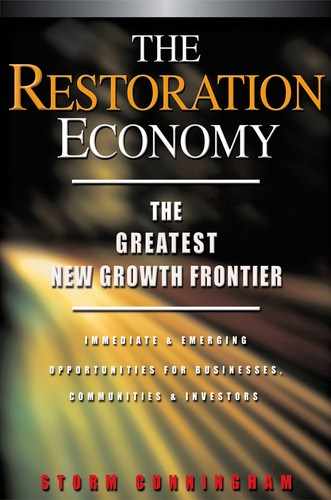Part Four
Putting It All Together
In times of drastic change, it is the learners who inherit the future. The learned usually find themselves equipped to live in a world that no longer exists.
—Eric Hoffer, Reflections on the Human Condition, 1973
In Part One, we saw how development’s three modes—new development, maintenance/conservation, and restorative development—apply to both built and natural environments. We saw how awareness of three global crises—Constraint, Corrosion, and Contamination—helps us think more clearly about our restored future. After some historical context, Part One also explained the Restoration Economy’s “invisibility.”
Part Two divided the business of restoration into four industries restoring the natural environment, and described their characteristics, players, principles, trends, and opportunities. Part Three did the same for the built environment.
Parts Two and Three were a high-level flyover of the realm of restorative development. Here in Part Four, we return to the broader view of Part One, this time to examine where we go from here and to think about three things:
- How restorative development affects conservation of the natural world, and how it affects the organizations and agencies whose mission is conservation.
- 236How restorative development relates to sustainable development, and how it will affect the organizations and agencies that are championing sustainability.
- How restoration of built and natural environments fits together, forming a path to accelerated economic growth. Towards that end, Chapter 15 offers a national case study.
Part Four thus focuses on that tricky, oh-so-evasive issue of balancing present-day economic growth with environmental health, and with the economic future of our children.
It’s easy to point to the new development realm’s antienvironment politicians and business leaders as the source of our environmental problems, but our marginal progress also stems from overreliance on conservation and sustainable development as remedies. We’ve been largely ignoring the third—arguably the most economically vigorous and sustainable—of the three development modes: restorative development.
Conservation and sustainable development are not remedies. Conservation protects something from new development, but that is seldom enough. Combine conservation with ecological restoration, however, and now a pristine ecosystem is not just protected; it is able to expand its domain (maybe for the first time in centuries) into the damaged land around it.
Aldo Leopold called it “a wilderness on its last legs.” Now, the North Woods of Wisconsin is a comeback site for bears, fishers, and wolves.
—John Hildebrand, “A Winter Wildland,” Audubon, January-February 2000
Sustainable development also is not a complete remedy, for different reasons. It has tended to focus too heavily on making new development less damaging. This is, no doubt, a truly important mission, but the downside is that sustainable development too often becomes a force for perpetuating new development at the cost of restorative development, which would do far more good. Sustainable development has thus been floundering at the most resistant end of the life cycle. The good news is that there’s nothing to stop it from focusing more attention at the restorative end. Even better news is that the best sustainability projects are already doing just that.
Chapter 15 attempts to encapsulate as many of the book’s points as possible in an informal case study of the charming little island nation of Bermuda. The Conclusion provides a retrospective (and introspective) cap, plus a big-picture look forward.
